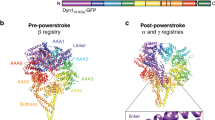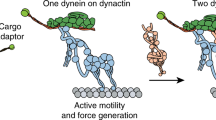Abstract
The motor protein dynein is predicted to move the tail domain, a slender rod-like structure, relative to the catalytic head domain to carry out its power stroke. Here, we investigated ATP hydrolysis cycle–dependent conformational dynamics of dynein using fluorescence resonance energy transfer analysis of the dynein motor domain labeled with two fluorescent proteins. We show that dynein adopts at least two conformational states (states I and II), and the tail undergoes ATP-induced motions relative to the head domain during transitions between the two states. Our measurements also suggest that in the course of the ATP hydrolysis cycle of dynein, the tail motion from state I to state II takes place in the ATP-bound state, whereas the motion from state II to state I occurs in the ADP-bound state. The latter tail motion may correspond to the predicted power stroke of dynein.
This is a preview of subscription content, access via your institution
Access options





Similar content being viewed by others
References
Paschal, B.M. & Vallee, R.B. Retrograde transport by the microtubule-associated protein MAP 1C. Nature 330, 181–183 (1987).
Holzbaur, E.L. & Vallee, R.B. DYNEINS: molecular structure and cellular function. Annu. Rev. Cell Biol. 10, 339–372 (1994).
Vallee, R.B. & Sheetz, M.P. Targeting of motor proteins. Science 271, 1539–1544 (1996).
Hirokawa, N. Kinesin and dynein superfamily proteins and the mechanism of organelle transport. Science 279, 519–526 (1998).
Karki, S. & Holzbaur, E.L. Cytoplasmic dynein and dynactin in cell division and intracellular transport. Curr. Opin. Cell Biol. 11, 45–53 (1999).
Vale, R.D. The molecular motor toolbox for intracellular transport. Cell 112, 467–480 (2003).
King, S.J., Bonilla, M., Rodgers, M.E. & Schroer, T.A. Subunit organization in cytoplasmic dynein subcomplexes. Protein Sci. 11, 1239–1250 (2002).
Neuwald, A.F., Aravind, L., Spouge, J.L. & Koonin, E.V. AAA+: a class of chaperone-like ATPases associated with the assembly, operation, and disassembly of protein complexes. Genome Res. 9, 27–43 (1999).
Koonce, M.P. & Samso, M. Overexpression of cytoplasmic dynein's globular head causes a collapse of the interphase microtubule network in Dictyostelium. Mol. Biol. Cell 7, 935–948 (1996).
Nishiura, M. et al. A single-headed recombinant fragment of Dictyostelium cytoplasmic dynein can drive the robust sliding of microtubules. J. Biol. Chem. 279, 22799–22802 (2004).
Habura, A., Tikhonenko, I., Chisholm, R.L. & Koonce, M.P. Interaction mapping of a dynein heavy chain. Identification of dimerization and intermediate-chain binding domains. J. Biol. Chem. 274, 15447–15453 (1999).
Tynan, S.H., Gee, M.A. & Vallee, R.B. Distinct but overlapping sites within the cytoplasmic dynein heavy chain for dimerization and for intermediate chain and light intermediate chain binding. J. Biol. Chem. 275, 32769–32774 (2000).
Gee, M.A., Heuser, J.E. & Vallee, R.B. An extended microtubule-binding structure within the dynein motor domain. Nature 390, 636–639 (1997).
Koonce, M.P. Identification of a microtubule-binding domain in a cytoplasmic dynein heavy chain. J. Biol. Chem. 272, 19714–19718 (1997).
Samso, M., Radermacher, M., Frank, J. & Koonce, M.P. Structural characterization of a dynein motor domain. J. Mol. Biol. 276, 927–937 (1998).
Fan, J. & Amos, L.A. Antibodies to cytoplasmic dynein heavy chain map the surface and inhibit motility. J. Mol. Biol. 307, 1317–1327 (2001).
King, S.M. AAA domains and organization of the dynein motor unit. J. Cell Sci. 113, 2521–2526 (2000).
Burgess, S.A., Walker, M.L., Sakakibara, H., Oiwa, K. & Knight, P.J. The structure of dynein-c by negative stain electron microscopy. J. Struct. Biol. 146, 205–216 (2004).
Gibbons, I.R., Gibbons, B.H., Mocz, G. & Asai, D.J. Multiple nucleotide-binding sites in the sequence of dynein beta heavy chain. Nature 352, 640–643 (1991).
Ogawa, K. Four ATP-binding sites in the midregion of the beta heavy chain of dynein. Nature 352, 643–645 (1991).
Koonce, M.P., Grissom, P.M. & McIntosh, J.R. Dynein from Dictyostelium: primary structure comparisons between a cytoplasmic motor enzyme and flagellar dynein. J. Cell Biol. 119, 1597–1604 (1992).
Mocz, G. & Gibbons, I.R. Phase partition analysis of nucleotide binding to axonemal dynein. Biochemistry 35, 9204–9211 (1996).
Kon, T., Nishiura, M., Ohkura, R., Toyoshima, Y.Y. & Sutoh, K. Distinct functions of nucleotide-binding/hydrolysis sites in the four AAA modules of cytoplasmic dynein. Biochemistry 43, 11266–11274 (2004).
Silvanovich, A., Li, M.G., Serr, M., Mische, S. & Hays, T.S. The third P-loop domain in cytoplasmic dynein heavy chain is essential for dynein motor function and ATP-sensitive microtubule binding. Mol. Biol. Cell 14, 1355–1365 (2003).
Reck-Peterson, S.L. & Vale, R.D. Molecular dissection of the roles of nucleotide binding and hydrolysis in dynein's AAA domains in Saccharomyces cerevisiae. Proc. Natl. Acad. Sci. USA 101, 1491–1495 (2004).
Vallee, R.B. & Gee, M.A. Make room for dynein. Trends Cell Biol. 8, 490–494 (1998).
Vale, R.D. AAA proteins. Lords of the ring. J. Cell Biol. 150, F13–F19 (2000).
Asai, D.J. & Koonce, M.P. The dynein heavy chain: structure, mechanics and evolution. Trends Cell Biol. 11, 196–202 (2001).
Burgess, S.A., Walker, M.L., Sakakibara, H., Knight, P.J. & Oiwa, K. Dynein structure and power stroke. Nature 421, 715–718 (2003).
Johnson, K.A. Pathway of the microtubule-dynein ATPase and the structure of dynein: a comparison with actomyosin. Annu. Rev. Biophys. Biophys. Chem. 14, 161–188 (1985).
Shimizu, T. & Johnson, K.A. Presteady state kinetic analysis of vanadate-induced inhibition of the dynein ATPase. J. Biol. Chem. 258, 13833–13840 (1983).
Gibbons, I.R. et al. Photosensitized cleavage of dynein heavy chains. Cleavage at the “V1 site” by irradiation at 365 nm in the presence of ATP and vanadate. J. Biol. Chem. 262, 2780–2786 (1987).
Takahashi, Y., Edamatsu, M. & Toyoshima, Y.Y. Multiple ATP-hydrolyzing sites that potentially function in cytoplasmic dynein. Proc. Natl. Acad. Sci. USA 101, 12865–12869 (2004).
Ogura, T. & Wilkinson, A.J. AAA+ superfamily ATPases: common structure—diverse function. Genes Cells 6, 575–597 (2001).
Whiteheart, S.W. et al. N-ethylmaleimide-sensitive fusion protein: a trimeric ATPase whose hydrolysis of ATP is required for membrane fusion. J. Cell Biol. 126, 945–954 (1994).
Babst, M., Wendland, B., Estepa, E.J. & Emr, S.D. The Vps4p AAA ATPase regulates membrane association of a Vps protein complex required for normal endosome function. EMBO J. 17, 2982–2993 (1998).
Wang, Q., Song, C., Yang, X. & Li, C.C. D1 ring is stable and nucleotide-independent, whereas D2 ring undergoes major conformational changes during the ATPase cycle of p97-VCP. J. Biol. Chem. 278, 32784–32793 (2003).
Bagshaw, C.R. et al. The magnesium ion-dependent adenosine triphosphatase of myosin. Two-step processes of adenosine triphosphate association and adenosine diphosphate dissociation. Biochem. J. 141, 351–364 (1974).
Holzbaur, E.L. & Johnson, K.A. ADP release is rate limiting in steady-state turnover by the dynein adenosinetriphosphatase. Biochemistry 28, 5577–5585 (1989).
Holzbaur, E.L. & Johnson, K.A. Microtubules accelerate ADP release by dynein. Biochemistry 28, 7010–7016 (1989).
Tani, T. & Kamimura, S. Dynein-ADP as a force-generating intermediate revealed by a rapid reactivation of flagellar axoneme. Biophys. J. 77, 1518–1527 (1999).
Holmes, K.C. The swinging lever-arm hypothesis of muscle contraction. Curr. Biol. 7, R112–R118 (1997).
Suzuki, Y., Yasunaga, T., Ohkura, R., Wakabayashi, T. & Sutoh, K. Swing of the lever arm of a myosin motor at the isomerization and phosphate-release steps. Nature 396, 380–383 (1998).
Shih, W.M., Gryczynski, Z., Lakowicz, J.R. & Spudich, J.A. A FRET-based sensor reveals large ATP hydrolysis-induced conformational changes and three distinct states of the molecular motor myosin. Cell 102, 683–694 (2000).
Rice, S. et al. A structural change in the kinesin motor protein that drives motility. Nature 402, 778–784 (1999).
Blaauw, M., Linskens, M.H. & van Haastert, P.J. Efficient control of gene expression by a tetracycline-dependent transactivator in single Dictyostelium discoideum cells. Gene 252, 71–82 (2000).
Sloboda, R.D. & Rosenbaum, J.L. Purification and assay of microtubule-associated proteins (MAPs). Methods Enzymol. 85, 409–416 (1982).
Clegg, R.M. Fluorescence resonance energy transfer and nucleic acids. Methods Enzymol. 211, 353–388 (1992).
Acknowledgements
We thank P.J. Van Haastert for providing us with the tetracycline-regulated expression system. This work was partly supported by the Grant-in-Aid for Scientific Research (B) from the Ministry of Education, Culture, Sports, Science and Technology of Japan (MEXT), by the Grant-in-Aid for Scientific Research on Priority Areas from MEXT, by the Special Coordination Funds for Promoting Science and Technology from MEXT and by the Core Research for Evolutional Science and Technology (CREST) program grant from the Japan Science and Technology Agency (JST).
Author information
Authors and Affiliations
Corresponding author
Ethics declarations
Competing interests
The authors declare no competing financial interests.
Rights and permissions
About this article
Cite this article
Kon, T., Mogami, T., Ohkura, R. et al. ATP hydrolysis cycle–dependent tail motions in cytoplasmic dynein. Nat Struct Mol Biol 12, 513–519 (2005). https://doi.org/10.1038/nsmb930
Received:
Accepted:
Published:
Issue Date:
DOI: https://doi.org/10.1038/nsmb930
This article is cited by
-
Lis1 slows force-induced detachment of cytoplasmic dynein from microtubules
Nature Chemical Biology (2024)
-
The regulatory function of the AAA4 ATPase domain of cytoplasmic dynein
Nature Communications (2020)
-
Molecular mechanism of cytoplasmic dynein tension sensing
Nature Communications (2019)
-
Step Sizes and Rate Constants of Single-headed Cytoplasmic Dynein Measured with Optical Tweezers
Scientific Reports (2018)
-
Overview of the mechanism of cytoskeletal motors based on structure
Biophysical Reviews (2018)



